SIG SAUER continues to flesh out its Sig Optics line of products in its quest to dominate nearly every aspect of the firearms and accessories marketplace. I previously reviewed a scope from their hunting-oriented line, the WHISKEY5, and last December took delivery of this TANGO6 3-18x44mm from their tactical line.
Yes, that’s correct, I’ve been using it regularly for nearly a year now. It has moved from gun to gun, acting as my go-to optic for accuracy testing. During this time I’ve shot with optics from Kahles, Nightforce, Steiner, US Optics, and many others, and the TL:DR version of this review is that the TANGO6 can definitely hang with this crowd.
Sig Optics’ apparent goal with their offerings is to provide premium quality at a comparably (for the given quality) low price point. This may be most clearly seen in their KILO rangefinders, which punch way out of their price category and are very likely the best rangefinder on the market for the dollar. Heck, on straight-up range finding capability they’re some of the quickest, most capable civilian units at any price. When it comes to scopes, it can be a little harder to quantify without getting horribly science-y, but everything I’ve seen so far has left me impressed.
Speaking of seeing clearly, let’s just jump right to it. Seen above is the view — HDR photo, so there’s a little halo effect off black surfaces that doesn’t exist in real life — through the TANGO6 at 3x zoom on an overcast day. That’s the minimum zoom level my 3-18x version allows, of course, but the TANGO6 line also includes a 1-6×24, a 2-12×40, and a 5-30×56.
And this is the view at 18x.
 As you can tell, I’ve chosen the first focal plane version with an MOA milling reticle from the five reticle options available in the 3-18x TANGO6.
As you can tell, I’ve chosen the first focal plane version with an MOA milling reticle from the five reticle options available in the 3-18x TANGO6.
The entire milling section of the reticle is red illuminated, with 11 brightness settings — one marked IR for infrared night vision, one low setting for other night vision use, then 8 that are bright enough to see with the bare eye. Between each “on” click is an “off” click (“off” being the 11th setting, even if there are a bunch of “off” locations), so your go-to brightness level is only a single click away.
On full bright, it stands out pretty darn well (my cell phone, which is the least frustrating way to get through-the-scope pics, auto-adjusts and subdues the brightness a bit). It’s no red dot for full-sun use, but it glows clearly on most days. Yet it remains crisp and clean without bleeding (the majority of the focus blur towards the periphery in the zoomed-in pic above is due to my phone, however a small degree is visible to the eye). Even with the dial left in an “on” position, illumination automatically powers off after 6 motionless minutes, then comes right back on with the first sign of motion.
Sharing the illumination turret, but obviously with its own dial, is the TANGO6’s parallax adjustment. Even on 18x zoom, it really will focus properly and be parallax-free at least as close as 25 yards, which is the lowest point on the dial. As with any scope it adjusts up to infinity, with markings — but no clicks; it adjusts smoothly like a focus ring should — along the way at 25, 30, 40, 50, 60, 75, 100, 150, and 300 yards.
While it’s quite common to find that parallax distance markings on the turret do not align with elimination of parallax error at those actual distances, these marks were absolutely dead-on at all ranges. After initially testing with it from 25 to 880 yards and everywhere in between, I took to trusting the dial implicitly. That saves time and mental energy.
The uncapped elevation and windage turrets do lock to avoid accidental rotation. Pull up to unlock and adjust, push down to lock. As you can see in the right photo above, when the turret is lifted for adjustment a rotation indicator appears to let you know which turn you’re on.
All TANGO (and most WHISKEY) scope model purchases net the owner a free SBT, or SIG Ballistic Turret. This is a custom, laser-etched elevation dial that matches your bullet specs, velocity, elevation, and other environmental factors to yardage. Meaning, instead of MOA or MRAD marks on the turrets, it’s yards. Taking a shot at 550 yards? Just spin the turret to 550 (marked as 5.5 on the dial) and you’re re-zeroed.
The turret itself can be set to zero by loosening its three, 2mm set screws, rotating it until it’s zeroed with the line on the turret base, and then tightening it back down. If desired, a zero stop can also be set. The zero stop allows you to adjust elevation upwards from your zero for taking longer shots, but when you dial back down it stops hard right at zero; no eyes or finesse necessary. To set the zero stop, the adjustment shroud is removed, the zero stop collar is spun clockwise until it stops, then it’s tightened down. It’s an easy enough process, but requires a 2mm and a 1.5mm hex wrench.
While there is no extended throw lever offered at this time, the zoom adjust ring is covered in aggressively-checkered sections and wide grooves. The raised zoom level indicator has two, green fiber optic tubes making it easy to push and easy to see.
Even from behind the scope, the indicator is easy to spot.
On the objective side, 46×0.75mm threads allow the use of various accessories like shades, flash killers, filters, etc. TANGO6 lenses receive a list of features and treatments: Spectracoat, Lensarmor, HDX (high definition, high transmittance glass), and Lenshield. Full descriptions of each, plus those of the myriad other features of the TANGO6 line, are on the Sig Optics site here.
On The Range
Let’s just get the negatives out of the way here first: the 30mm tube diameter means a slightly smaller field of view (5.9 feet at 100 yards, at 18x zoom) and a smaller elevation adjustment range (72 MOA) than most of the premium optics in this category that are going with 34mm tubes. Even among 30mm tube, premium optics, actually, the field of view is on the low end of average, and the elevation adjustment range is underwhelming. Although a 2.4mm exit pupil at full zoom is easy enough to use, a larger objective lens wouldn’t hurt (other than hurting low-mounting capability a little bit, sure).
On the plus side, the 3-18x here also has 72 MOA of windage adjustment, which is impressive even among many 34mm tube diameter, extremely high-end scopes. Not that you’re likely to use it. I’d gladly take the usual trade-off in less windage adjustment and more elevation adjustment. That said, this may be a big way in which Sig Optics has created an extremely robust, mechanically-accurate optic at a competitive price against its competition.
Weighing in at 31.8 ounces it’s no lightweight, but it’s lighter than much of the competition; especially the 34mm crowd. Balance is fairly decently centered, which is a plus.
Back to the mechanical function of the TANGO6, I’ve found it excellent and spot-on. While, normally, with a 40 MOA tape in the reticle I would zero this optic and never again touch the dials, in order to test the mechanical accuracy of the turret adjustments I like to stretch things out and dial in the new zero. Using a ballistics app while shooting 5.56, .308, and .22 LR with this scope, the adjustments were dead-on out to the max range I dialed in on 5.56 (600 yards, 15.2 MOA aka 61 clicks up).
Unfortunately, due to the mount I randomly chose to use and/or how my go-to AR upper shoots, with a 100-yard zero I was left with only ~19 MOA more elevation on the turret. On the one hand, testing it out to 600 yards and 15.2 MOA of “up” adjustment proved that the TANGO6 click values are accurate even near the end of the adjustment range. On the other hand, I’m starting out closer to the end of that adjustment range than I’d want and run out of clicks at about 665 yards, which is inside of the accurate range of my AR-15. On the third hand, with a reticle like this all I actually care about is being able to zero; I’m using the tape for holdovers anyway, and it has me covered to 935 yards with a 100 yard zero shooting M193.
Another testament to mechanical accuracy is the fact that, after moving — and re-zeroing! — the scope between a handful of rifles and even my 9mm CZ Scorpion Evo, it always returned precisely to zero when going back onto my AR. Adjustment clicks, by the way, are solid and precise.
Optically, the glass is as good as in any riflescope coming out of Japan. Which is to say that the image is bright and sharp with excellent color. It’s as good as or better than anything in its price range and, as mentioned earlier, it hangs with many optics costing over a thousand bucks more. The reticle is crisp and useful, although if I had my way I’d add some numbers to the vertical tape to make finding holds easier and faster. Illumination is bright, and doesn’t wash out the edges of the etched reticle.
Conclusions
SIG’s TANGO6 product line has the optical clarity, mechanical accuracy, and, apparently, durability of other premium optics that often cost significantly more. They are, indeed, premium optics with high-end features and high-quality components.
If the 3-18x (and 5-30x) falls short anywhere, it’s in the smaller amount of elevation adjustment than most of its peers. Obviously in the current market there’s no shortage of mounts and rails with MOA cant built into them, but I don’t like coming so close to actually requiring one while shooting inside of 650 yards (well, given that I feel the need to dial in the range). Of course, it’s fair to say that my AR-15 setup is a bit unlucky in that I’m way up the elevation adjustment simply to zero at 100, which wasn’t the case on the other guns.
I like the aesthetics of these scopes, too. The gray finish on the tube looks nice with every gun I’ve put it on — although none of mine are as sexy as Joe Grine‘s “Mausingfield,” seen above with a SIG TANGO6 5-30×56 on it — and the machining and finish on the black turrets and controls are excellent. Everything is crisp, clean, even, snug, and smooth.
Specifications: SIG SAUER TANGO6 3-18×44
Reticle Options: MOA or MRAD Milling in first focal plane, MOA or MRAD Milling in second focal plane, or HellFire Triplex in second focal plane
Adjustment Value: 0.25 MOA or 0.1 MRAD
Adjustment Range: 72 MOA or 20.9 MRAD, for both elevation and windage
Illumination Settings: 9 daytime, 2 night vision
Field of View: 35.3 ft at 3x, 5.9 ft at 18x
Eye Relief: 3.9 in
Exit Pupil: 11.4 mm at 3x, 2.4 mm at 18x
Weight: 31.8 oz
Length: 15.3 in
Tube Diameter: 30mm
Water Resistance Rating: IPX-7 (immersion to 1 meter for 30 minutes)
Caliber Restrictions: None
Other Features: HDX optics extra low-dispersion, high transmittance glass, Spectracoat, Lensarmor, Lenshield, MOTAC motion activated illumination, LockDown zero system, turret rotation counter, one free SIG Ballistic Turret
Warranty: 5-Year on electronic components, and “Infinite Guarantee” on the rest (“unlimited lifetime guarantee, fully transferable, no warranty card required, no receipt required, no time limit applies, no charge”)
MSRP: $2,249.99 (street price ~$1,799 shipped)
Ratings (out of five stars):
Glass Quality * * * * *
It isn’t flawless, but you can spend a grand more and see little-to-no improvement. The area left to improve, though, is minor distortion around the circumference of the lens, noticed mostly as a slight hazing of the reticle when zoomed in.
Reticle * * * 1/2
I like it and it’s perfectly usable, it just isn’t anything special. I’d like it more if it had numerical markings on it to make finding the correct holdover faster. For accuracy work, the 0.2 MOA center dot completely surrounded by 0.7 MOA of empty glass is great.
Turrets * * * * *
The machining and checkering feel great, the clicks are crisp and precise, and the locking, zero stopping, and re-zeroing functions work just as they should. A free, custom turret is pretty cool, too.
Mechanicals * * * *
Rock solid, repeatable, and accurate. But 72 MOA of elevation adjustment falls short of the modern norm at this quality and price level, and the field of view is a bit tight.
Overall Rating * * * *
The TANGO6 is a very high-quality, solid optic with choice glass, excellent function, good looks, and a killer warranty at a very competitive price.




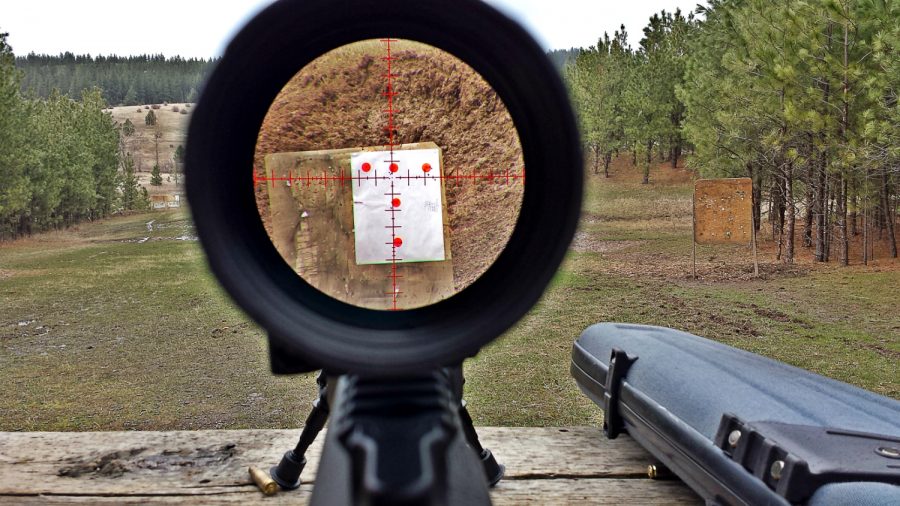

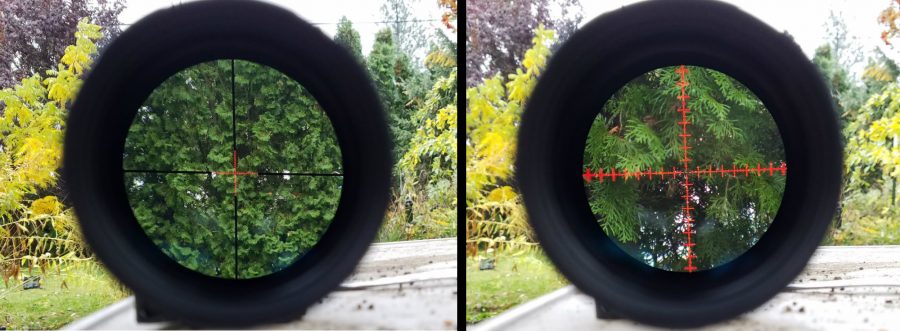
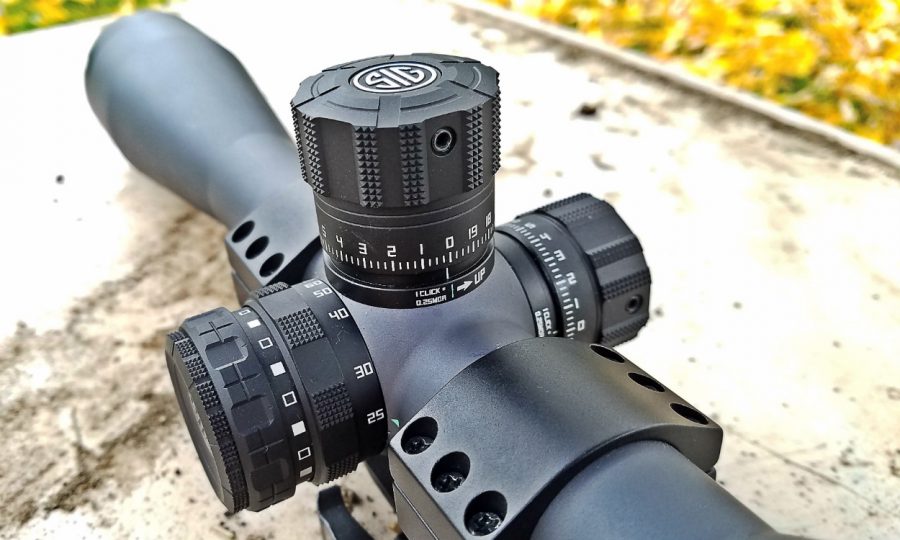

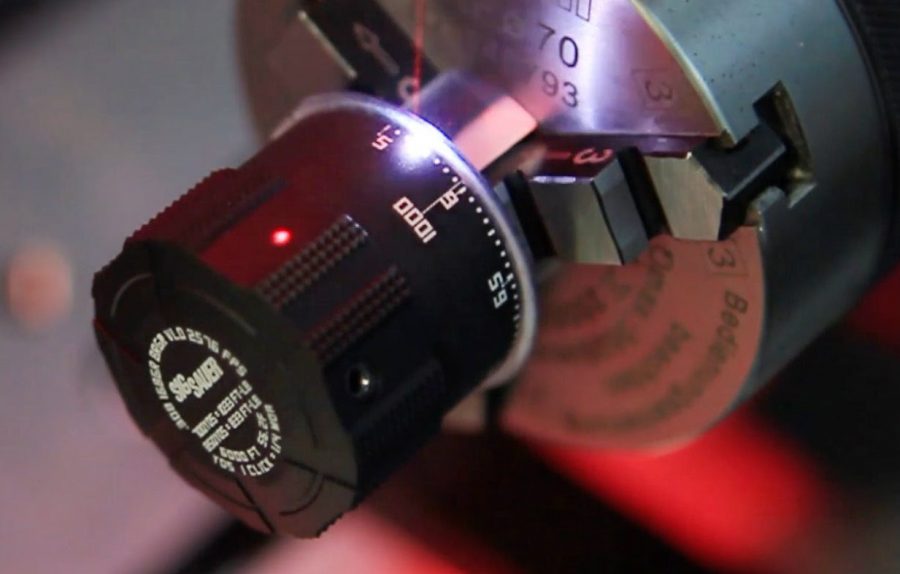
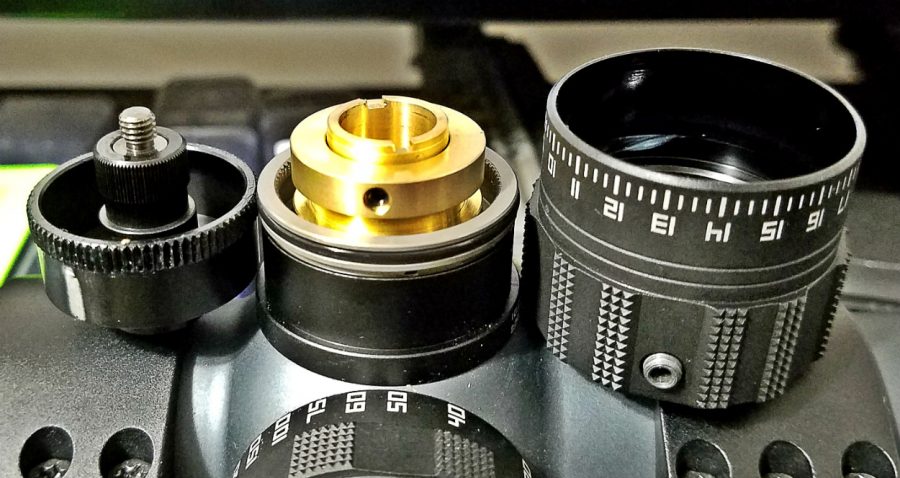
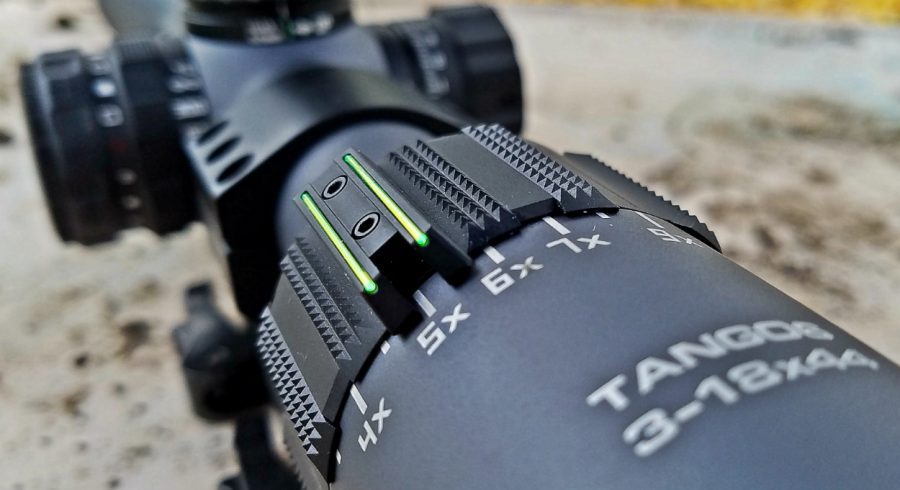


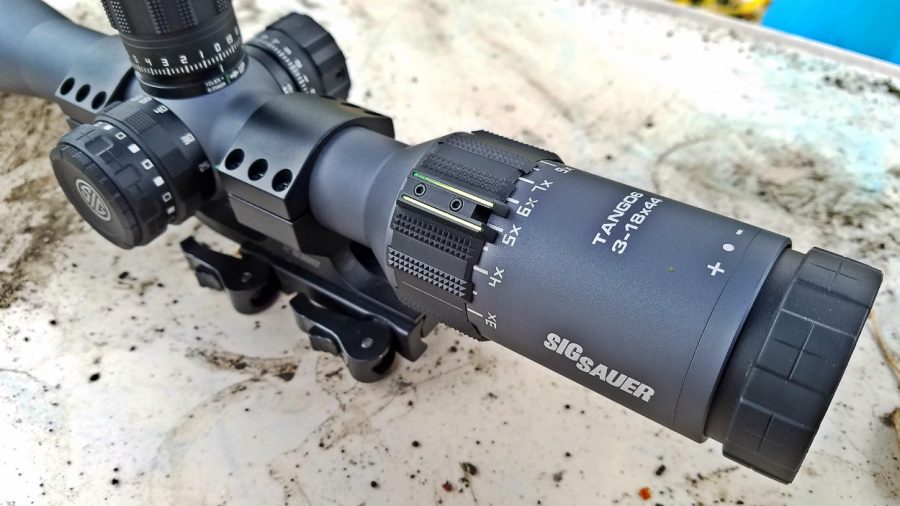




I think I found the scope I’m going to drop on my .308 DMR once it gets out of the shop. My gunsmith went to town on that thing with a precision 20″ bull barrel and a nice Timney trigger pack. Should be good to go by Christmas if my new Aero lower ever gets here. The 5-30×56 looks like an amazing option for the price point.
As I’m using mine primarily for the purpose of doing 100 yard accuracy groups with review guns, I think I’m going to sell this one and buy a 5-30x myself. Normally excessive for the ranges I shoot at, but it helps to be extra precise and try to take as much of my own fudge factor out of the equation when publishing accuracy results (and I have a 6.5 Grendel and a .204 Ruger AR, both highly precise guns, plus a nice .308 bolt gun and my own “match-grade” .223 upper build on the way).
Plus the new ones have SIG’s “LevelPlex” integrated into the reticle, which is super freaking cool. It’s a small light on the extreme right and extreme left sides of the sight picture, and they’re both off if the scope is perfectly level and one or the other will light up if the scope is tilted towards it. Accurate to like a tenth of a degree, but I believe they scaled it back to 0.5 degrees because it was just too hard to actually be “flat” otherwise haha. At any rate, it’s WAY more accurate than a bubble level and it’s instant and totally visible while you have a normal sight picture. Here’s a crappy photo I took of it in the 5-30x (and it’ll expand into the rest of the line soon, I believe) at NRA annual meetings: https://www.instagram.com/p/BFo6M1TvziV/
i know not exactly apples to apples, but how does it compare to say the Vortex Razor HD Gen II
That Vortex scope is excellent. Glass is also top notch.
Obvious differences in the SIG’s favor are that the Vortex 3-18x’s MSRP is $550 higher and it’s nearly 50% (15 freakin’ ounces) heavier. I personally like the texture / machining on the SIG’s zoom dial quite a bit more, but am basically ambivalent on that aspect of the turrets. Although I do like how SIG has designed the illumination dial a little better.
In the Vortex’s favor, the 50mm objective and 34mm tube likely mean, ultimately, more light transmission and a slightly larger exit pupil. They do mean a larger field of view (6.25 ft at 100 yds at 18x, vs. the SIG’s 5.9 ft) and more elevation adjustment (a whopping 120 MOA, which is very impressive). Now…how accurately does that adjustment track? I don’t have enough personal experience with the scope to say. But, in actual practice, like the SIG I really don’t care since it has a great reticle and I’d simply holdover for various distances and never touch the dials once zeroed anyway. The Vortex’s “infinite zero” feature is cool (allows you to adjust elevation between clicks for a perfect zero, e.g. if going up 0.1 mil puts you a little too high but going back down 0.1 mil puts you a little too low, you can use the “infinite zero” to get yourself into the middle zone).
It looks looks to me like the level plex is only available on the smaller 50mm primary lens. Is it worth giving up 6mm of light gathering to get the extra function? Me thinks that at 15x the extra surface area on the primary lens would make a difference. You’re looking at ~25% more surface area with the 56 over the 50.
There is no TANGO6 with a 50mm objective. LevelPlex is available for all of the reticles in the 5-30x56mm: https://www.sigoptics.com/model/tango6-5-30×56-mm/
It’s my understanding that the functionality is going to be added to the entire TANGO6 line and into other Sig Optics lines as well, at least for the scopes that don’t go down to 1x (e.g. 1-6×24).
Jeremy have you done any writeups or videos about your Grendel upper?
It isn’t here yet. It’ll be a complete AR from Precision Firearms, but they’ve been very, very busy with orders (and it’s almost entirely made-to-order stuff from them) so mine is still in the works. One day here — hopefully soon! — I’ll be sending some 6.5 G downrange 🙂
wtf, yall make it sound like this thing is affordable.
It’s a $2,249 scope competing very well against $2,999 to $3,999 scopes. I never said affordable, I said a comparably low price at this level of quality (compared to its peers / competition in this segment of the market). “Affordable” is entirely subjective / personal, so I wouldn’t presume to tell somebody that a $249 scope is “affordable” any more than I would a $2,000 scope. Either one could be far outside of what is affordable to any given person. Is this scope priced well against its competition? Yes. Is it affordable? That’s up to you.
I would love to see this compared to a Vortex Viper PST. Is it $1500 better?
The PST is not anywhere close to being in the same league.
If the choice is an extra grand worth of glass or an extra grand worth of gun, you’ll get more out of that grand in glass pretty much every time.
So… Sig has a WHISKEY line, and a TANGO line. Is the FOXTROT line coming soon?
http://www.sigoptics.com/product/foxtrot1/
So their whole line literally is W…T…F. I wouldn’t have suspected, but it looks like SIG has a sense of humor.
They appear to be going through most of the alphabet. There’s Tango, Whiskey, Bravo, Romeo, X-Ray, Echo, Foxtrot, Lima, Kilo, Oscar, and Zulu so far (just from looking at the Sig Optics website). So…yeah…you can make WTF from that but eventually it looks like you’ll be able to spell most words from their product line haha
So there’s the Whiskey line… there’s the Tango line… will there be a Foxtrot?
No joke, thats their line of weapons lights
Being FFP, is the reticle usable at the lower end, i.e. at 3x, 4x, etc?
The crosshairs and the 4 MOA-wide, 4 MOA-apart milling marks are perfectly visible at 3x. It’s easy enough to split those in half (e.g. “hold 6 high”). Using them for accurate ranging at low zoom, though, would be very difficult. For me the 1 MOA and 2 MOA marks become clear enough above 6x that I’d be comfortable ranging with them. At any zoom level, the dead center of the reticle is obvious.
Realizing now that I neglected to take a photo with the illumination off. I’ll see if I can do that today and add it to the post. Will try to get 3x, like 7x, and 18x for comparison purposes.
Thanks very useful. Will share site with my friends
I have been looking for a sunshade in 46×0.75mm and have had zero luck, Do you have any links to them? Thanks, Chris